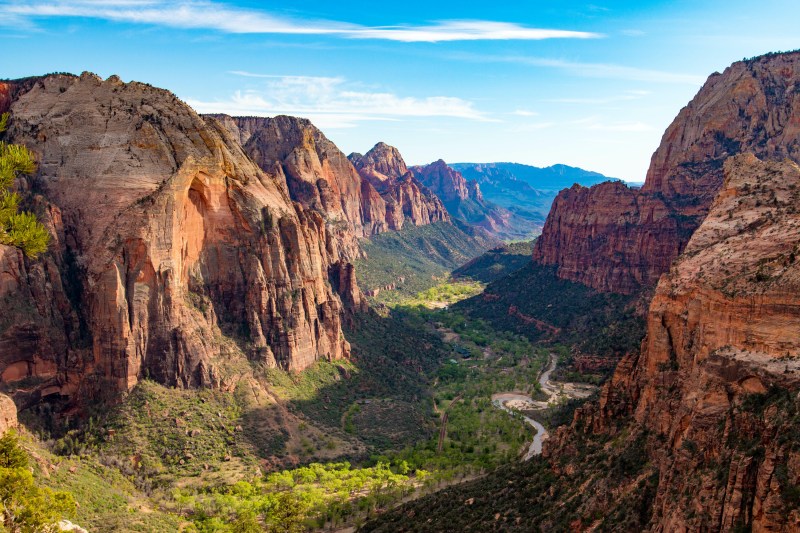Zion National Park, located in southwestern Utah, is known for its dramatic landscapes, towering sandstone cliffs, deep canyons, and, most especially, its gorgeous fall colors. It might not be as popular as the Great Smoky Mountains or Acadia National Park, but Zion has its own special magic that can only be seen during the autumn months. Ready to experience Zion National Park in fall? Here’s everything you need to know to make the most of your trip.
Make the most of your trip to Zion National Park in fall

Zion National Park is a must-visit for leaf peepers this season. To make the most of your trip, plan your visit for mid-October, when the leaves will probably be at their peak. It’s tough to predict peak season, so consulting a fall foliage map can help you time your trip. You’ll enjoy gorgeous golden cottonwood trees and red western sycamores along the Virgin River, bronze gambel oak in mid-elevation, and bigtooth maple at higher elevations. You might also see canyon grape vine, which turns a bright yellow during this season.
Once you arrive, be prepared to pay the $35 vehicle entry fee when you first enter, which is valid for seven days, or consider purchasing an “America The Beautiful” pass for year-round access. Additionally, you may need a permit or reservation for several activities around the park, such as Angels Landing or The Narrows. You may also need reservations for camping or backpacking, so if you’d like to do one of these activities, be sure to plan early and register at Recreation.gov. While Zion National Park isn’t super crowded during the fall, you can always plan your trip for a weekday if you want to be sure to miss the crowds.
Another thing to note is that it can be chilly at Zion National Park in the fall. The temperature ranges from 40-80°F (4-27°C) during the day, so be sure to dress in layers and wear sturdy, close-toed shoes for hikes. Bring snacks and water with you, and don’t forget to follow all park guidelines.
Top fall hikes at Zion National Park

Angels Landing
- Length: 5.4 miles round trip
- Rating: Strenuous
If you’re able to secure one of the coveted lottery permits to climb up to Angels Landing, definitely take the opportunity. This is one of the best views in the park, but the hike can be difficult due to the steep inclines, narrow, exposed sections, and the crowds. Only take on this challenge if you have decent balance and are in good health. Due to the high vantage, it’s not recommended for anyone with a fear of heights.
The first part of the hike involves a steady climb up a series of switchbacks known as “Walter’s Wiggles,” which leads to Scout Lookout. This in itself is a great workout and has a fantastic view, so if this is all you’re up for, you’re still in for a treat. From Scout Lookout, the last half mile is the most challenging, so if steep drop-offs aren’t your thing, it’s best to stop here.
Riverside Walk
- Length: 2 miles round trip
- Rating: Easy
If you’re looking for an easy and accessible trail, the Riverside Walk is the best one for you. This trail starts at the Temple of Sinawava, which is the final stop on the Zion Canyon Scenic Drive and Shuttle route. Depending on the season, you may need to purchase a ticket for the shuttle, but usually, in the fall, it’s included in your park entry fee.
Since it’s paved and mostly flat, this trail is super accessible for kids of all ages and can accommodate strollers or wheelchairs. The cottonwood trees grow on both sides of the river, so you’ll see plenty of bright yellow and golden fall colors. You might even photograph some wildlife drinking from the river! At the end, you’ll come to the gateway to The Narrows, where you can wade in the river or simply enjoy the canyon.
Taylor Creek Trail (Kolob Canyons)
- Length: 5 miles round trip
- Rating: Moderate
Located in the Kolob Canyons section of the park, this trail takes you through a narrow canyon filled with vibrant maple and oak trees that turn brilliant shades of red and orange in the fall. The trailhead is located in the Kolob Canyons section of Zion, about 40 miles north of Zion Canyon, so you’ll need to enter through the Kolob Canyons Visitor Center off I-15 at exit 40.
Unlike other trails in Zion, the Taylor Creek Trail doesn’t require a permit or reservation for day hiking. However, keep in mind that parking at the trailhead is on a first come-first serve basis. During fall weekends, the parking can fill up fast, so arrive early if you can.
This trail can be somewhat unpredictable, so be prepared to get a little muddy. You may need to cross a couple shallow creeks, so wear waterproof footwear. The weather in the fall is generally mild, but it’s always a good idea to check the weather forecast for rain to avoid any flash floods that might ruin your hike. When in doubt, be sure to ask the National Park Service officers for trail conditions and risks.




